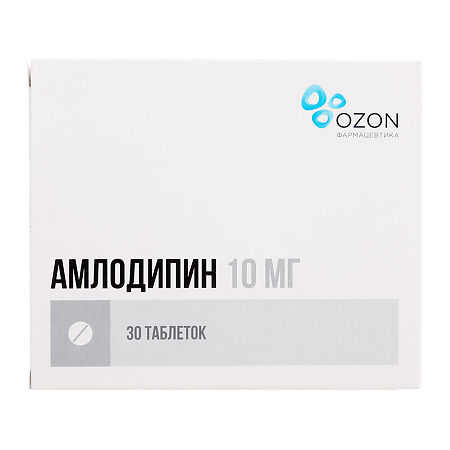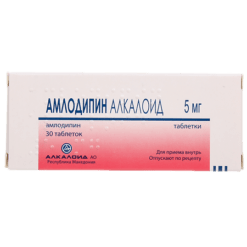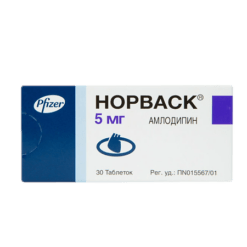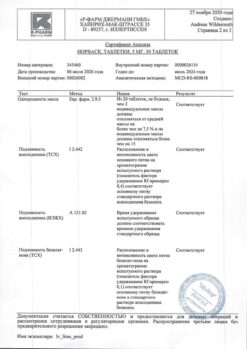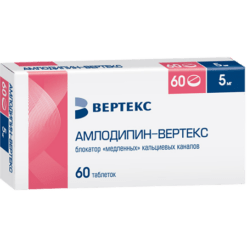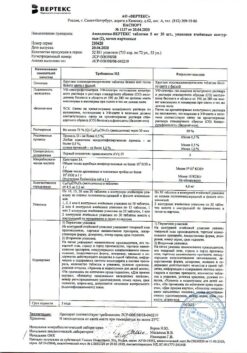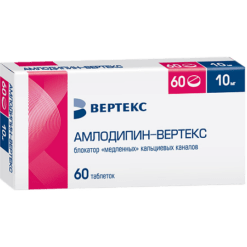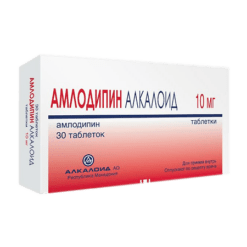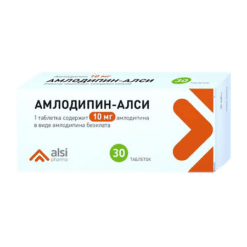No products in the cart.
Amlodipine, tablets 10 mg 30 pcs
€3.54 €2.95
Description
Pharmacotherapeutic group
Slow calcium channel blocker
ATX code: C08CA01
Pharmacodynamics:
The “slow” calcium channel blocker dihydropyridine derivative, a second-generation slow calcium channel blocker (BMCC), has antianginal and hypotensive effects. It blocks calcium channels decreases transmembrane transition of calcium ions into the cell (more in vascular smooth muscle cells than in cardiomyocytes).
The antianginal action is caused by the dilation of coronary and peripheral arteries and arterioles: in angina pectoris it reduces myocardial ischemia; dilation of peripheral arterioles reduces total peripheral vascular resistance (TPR) and decreases postcardiac load which reduces myocardial oxygen demand. By dilating the coronary arteries and arterioles in the unchanged and ischemic areas of the myocardium, it increases the oxygen supply to the myocardium (especially in vasospastic angina); prevents coronary artery spasm (including that caused by smoking). In patients with stable angina a single daily dose increases exercise tolerance increases time to an attack of angina and “coronary” ST-segment depression decreases the frequency of angina attacks and nitroglycerin consumption of other nitrates. It has a long-term dose-dependent hypotensive effect. The hypotensive effect is due to the direct vasodilating effect on the vascular smooth muscles. In arterial hypertension a single dose provides clinically significant reduction of blood pressure (BP) for 24 hours. (in patient’s “lying” and “standing” position). Orthostatic hypotension when prescribing amlodipine is rare. It does not cause decrease in left ventricular ejection fraction. It reduces the degree of left ventricular myocardial hypertrophy. Does not affect myocardial contractility and conduction does not cause reflex increases in heart rate
Inhibits platelet aggregation and increases glomerular filtration rate has a weak natriuretic effect.
In diabetic nephropathy it does not increase the severity of microalbuminuria. There is no adverse effect on metabolism and concentration of blood plasma lipids and it can be used for therapy of patients with bronchial asthma, diabetes mellitus and gout. Significant reduction in BP is observed after 6-10 hours the duration of effect is 24 hours.
. In patients with cardiovascular diseases including coronary atherosclerosis with lesion of one vessel and up to stenosis of 3Atherosclerosis of the carotid arteries with myocardial infarction, percutaneous transluminal angioplasty (TLAP) of the coronary arteries, or patients with angina, amlodipine prevents the development of carotid intima-media thickening and reduces mortality from myocardial infarction and stroke TLAP by coronary artery bypass grafting; leads to lower incidence of unstable angina and progression of chronic heart failure (CHF); reduces the frequency of interventions to restore coronary blood flow.
Does not increase risk of death or complications and lethal outcomes in patients with CHF (functional class III-IV according to NYHA classification) during therapy with digoxin diuretics and antotensin-converting enzyme inhibitors (ACEI). In patients with CHF (functional class III-IV according to NYHA classification) of non-ischemic etiology when using amlodipine there is a possibility of pulmonary edema.
Pharmacokinetics:
After oral administration, amlodipine is slowly absorbed from the gastrointestinal tract (GIT). Mean absolute bioavailability is 64% maximum concentration (Cmax) in blood serum is observed after 6-9 hours. Equilibrium concentrations (CSS) are reached after 7-8 days of therapy.
Eating does not affect absorption of amlodipine. Mean volume of distribution is 21 l/kg body weight which indicates that most of the drug is in tissues and less in blood. Most of the drug in blood (95%) is bound to plasma proteins. Amlodipine undergoes slow but active metabolism in the liver with no significant “first pass” effect. Metabolites have no significant pharmacological activity. After a single dose, the elimination half-life (T1/2) varies from 35 to 50 hours with a repeated use of T1/2 of approximately 45 hours. About 60% of oral dose is excreted by kidneys mainly as metabolites, 10% – unchanged, 20-25% – via intestine with bile. Total clearance of amlodipine is 0116 ml/s/kg (7 ml/min/kg 042 l/h/kg).
Elderly patients (over 65 years) have slower excretion of amlodipine (T1/2 is 65 h) compared to younger patients but this difference has no clinical significance. The prolonged T1/2 in patients with hepatic impairment suggests that long-term use will result in higher cumulation (T1/2- up to 60 h). Renal insufficiency has no significant effect on amlodipine kinetics. In patients with impaired renal function, changes in amlodipine plasma concentrations do not correlate with the degree of renal failure. Slight increase in T1/2 is possible.
Amlodipine penetrates the blood-brain barrier. It is not eliminated by hemodialysis.
Indications
Indications
– arterial hypertension.
– stable angina pectoris and vasospastic angina.
Pharmacological effect
Pharmacological effect
Pharmacotherapeutic group
blocker of “slow” calcium channels
ATX code: C08CA01
Pharmacodynamics:
Blocker of “slow” calcium channels, a dihydropyridine derivative – a blocker of “slow” calcium channels (SCBC) of the second generation has an antianginal and hypotensive effect. Blocks calcium channels and reduces the transmembrane transition of calcium ions into the cell (to a greater extent into vascular smooth muscle cells than into cardiomyocytes).
The antianginal effect is due to the expansion of the coronary and peripheral arteries and arterioles: in case of angina pectoris, it reduces the severity of myocardial ischemia; by expanding peripheral arterioles, it reduces total peripheral vascular resistance (TPR), reduces afterload on the heart, and reduces myocardial oxygen demand. By expanding the coronary arteries and arterioles in unchanged and ischemic areas of the myocardium, it increases the supply of oxygen to the myocardium (especially with vasospastic angina); prevents spasm of the coronary arteries (including those caused by smoking). In patients with stable angina, a single daily dose increases exercise tolerance, increases the time before the onset of an angina attack and “ischemic” depression of the ST segment reduces the frequency of angina attacks and the consumption of nitroglycerin and other nitrates. It has a long-term dose-dependent hypotensive effect. The hypotensive effect is due to a direct vasodilating effect on vascular smooth muscle. For arterial hypertension, a single dose provides a clinically significant reduction in blood pressure (BP) over 24 hours (with the patient lying and standing). Orthostatic hypotension when prescribing amlodipine is quite rare. Does not cause a decrease in left ventricular ejection fraction. Reduces the degree of left ventricular myocardial hypertrophy. Does not affect the contractility and conductivity of the myocardium does not cause a reflex increase in heart rate
contractions (heart rate) inhibits platelet aggregation increases glomerular filtration rate has a weak natriuretic effect.
In diabetic nephropathy, it does not increase the severity of microalbuminuria. It does not have any adverse effect on metabolism and plasma lipid concentrations and can be used in the treatment of patients with bronchial asthma, diabetes mellitus and gout. A significant decrease in blood pressure is observed after 6-10 hours, the duration of the effect is 24 hours.
In patients with diseases of the cardiovascular system, including coronary atherosclerosis with damage to one vessel and up to stenosis of 3 or more arteries, atherosclerosis of the carotid arteries who have had myocardial infarction, percutaneous transluminal angioplasty (PTPA) of the coronary arteries or patients with angina pectoris, the use of amlodipine prevents the development of intima-media thickening of the carotid arteries reduces mortality from myocardial infarction stroke TLAP coronary artery bypass grafting; leads to a decrease in the incidence of unstable angina and progression of chronic heart failure (CHF); reduces the frequency of interventions aimed at restoring coronary blood flow.
Does not increase the risk of death or the development of complications and deaths in patients with CHF (III-IV functional class according to the NYHA classification) during therapy with digoxin, diuretics and antotensin-converting enzyme (ACE) inhibitors. In patients with CHF (III-IV functional class according to the NYHA classification) of non-ischemic etiology, when using amlodipine, there is a risk of pulmonary edema.
Pharmacokinetics:
After oral administration, amlodipine is slowly absorbed from the gastrointestinal tract (GIT). The average absolute bioavailability is 64%; the maximum concentration (Cmax) in blood serum is observed after 6-9 hours. Steady-state concentrations (CSS) are achieved after 7-8 days of therapy.
Food intake does not affect the absorption of amlodipine. The average volume of distribution is 21 l/kg body weight, indicating that most of the drug is in the tissues and a smaller part is in the blood. Most of the drug in the blood (95%) binds to blood plasma proteins. Amlodipine undergoes slow but active metabolism in the liver with no significant first-pass effect. Metabolites do not have significant pharmacological activity. After a single dose, the half-life (T1/2) varies from 35 to 50 hours, with repeated use T1/2 is approximately 45 hours. About 60% of the dose taken orally is excreted by the kidneys mainly in the form of metabolites, 10% – unchanged, and 20-25% – through the intestines with bile. The total clearance of amlodipine is 0116 ml/s/kg (7 ml/min./kg 042 l/h/kg).
In elderly patients (over 65 years of age), the elimination of amlodipine is slower (T1/2 equal to 65 hours) compared to young patients; however, this difference is not clinically significant. Prolongation of T1/2 in patients with liver failure suggests that with long-term use, the accumulation of the drug in the body will be higher (T1/2 – up to 60 hours). Renal failure does not significantly affect the kinetics of amlodipine. In patients with impaired renal function, changes in plasma concentrations of amlodipine do not correlate with the degree of renal failure. A slight increase in T1/2 is possible.
Amlodipine penetrates the blood-brain barrier. It is not removed by hemodialysis.
Special instructions
Special instructions
During therapy with Amlodipine-Teva, it is necessary to monitor body weight and sodium intake; an appropriate diet is indicated.
It is necessary to maintain oral hygiene and follow-up with a dentist (to prevent painful bleeding and gum hyperplasia).
When using Amlodipine-Teva in patients with chronic heart failure of functional class III and IV according to the NYHA classification, pulmonary edema may develop.
In case of acute myocardial infarction, Amlodipine-Teva is prescribed after stabilization of hemodynamic parameters (see section “Contraindications”).
Patients with liver failure who need to take Amlodipine-Tev should be under medical supervision.
In elderly patients, T1/2 may increase and drug clearance may decrease. No dose changes are required, but more careful monitoring of patients in this category is necessary.
In patients with impaired renal function, monitoring of the condition is necessary. The effectiveness and safety of Amlodipine-Teva in hypertensive crisis has not been established.
Despite the absence of withdrawal syndrome in BMCC, it is advisable to discontinue treatment with Amlodipine-Teva by gradually reducing the dose of the drug.
Impact on the ability to drive vehicles. Wed and fur.:
Although no negative effects on the ability to drive vehicles or other complex mechanisms were observed while taking Amlodipine-Teva, however, due to a possible excessive decrease in blood pressure, the development of dizziness, drowsiness and other adverse reactions, caution should be exercised in these situations, especially at the beginning of treatment and when increasing the dose.
Active ingredient
Active ingredient
Amlodipine
Active components
Active components
During therapy with Amlodipine-Teva, it is necessary to monitor body weight and sodium intake; an appropriate diet is indicated.
It is necessary to maintain oral hygiene and follow-up with a dentist (to prevent painful bleeding and gum hyperplasia).
When using Amlodipine-Teva in patients with chronic heart failure of functional class III and IV according to the NYHA classification, pulmonary edema may develop.
In case of acute myocardial infarction, Amlodipine-Teva is prescribed after stabilization of hemodynamic parameters (see section “Contraindications”).
Patients with liver failure who need to take Amlodipine-Tev should be under medical supervision.
In elderly patients, T1/2 may increase and drug clearance may decrease. No dose changes are required, but more careful monitoring of patients in this category is necessary.
In patients with impaired renal function, monitoring of the condition is necessary. The effectiveness and safety of Amlodipine-Teva in hypertensive crisis has not been established.
Despite the absence of withdrawal syndrome in BMCC, it is advisable to discontinue treatment with Amlodipine-Teva by gradually reducing the dose of the drug.
Impact on the ability to drive vehicles. Wed and fur.:
Although no negative effects on the ability to drive vehicles or other complex mechanisms were observed while taking Amlodipine-Teva, however, due to a possible excessive decrease in blood pressure, the development of dizziness, drowsiness and other adverse reactions, caution should be exercised in these situations, especially at the beginning of treatment and when increasing the dose.
Composition
Composition
1 tablet contains:
Active substance:
Amlodipine besylate (amlodipine) -13.888 mg (10.00 mg).
Excipients: Microcrystalline cellulose, calcium hydrogen phosphate (anhydrous), sodium carboxymethyl starch (type A), magnesium stearate.
Pregnancy
Pregnancy
In experimental studies, the fetotoxic and embryotoxic effects of the drug have not been established, but use during pregnancy is possible only when the benefit to the mother outweighs the potential risk to the fetus.
There is no evidence of excretion of amlodipine in breast milk. However, it is known that other BMCA – dihydropyridine derivatives are excreted in breast milk. Therefore, if it is necessary to prescribe the drug Amlodipine-Teva during lactation, the issue of stopping breastfeeding should be resolved.
Contraindications
Contraindications
– hypersensitivity to amlodipine, other dihydropyridine derivatives and other components of the drug;
– severe arterial hypotension (systolic blood pressure less than 90 mm Hg);
– cardiogenic shock;
– acute myocardial infarction (within the first 28 days);
– unstable angina (with the exception of Prinzmetal’s angina);
– obstruction of the left ventricular outflow tract;
– clinically significant aortic stenosis;
– age under 18 years (efficacy and safety have not been established).
With caution:
liver function disorders sick sinus syndrome (severe bradycardia tachycardia) CHF of non-ischemic etiology III-IV functional class according to the NYHA classification arterial hypotension aortic stenosis mitral stenosis acute myocardial infarction (after the first 28 days) old age renal dysfunction.
Side Effects
Side Effects
The frequency of the adverse reactions listed below was determined according to the following (World Health Organization classification): very often – at least 10%; often – not less than 1% but less than 10%; infrequently – not less than 01% but less than 1%; rarely – not less than 001% but less than 01%; very rarely – less than 001% including individual messages.
From the central nervous system – often – headache (especially at the beginning of treatment), dizziness, increased fatigue, drowsiness; infrequently – general malaise hypoesthesia asthenia paresthesia peripheral neuropathy tremor insomnia emotional lability unusual dreams nervousness increased excitability depression anxiety increased sweating; rarely – convulsions, apathy, agitation; very rarely – ataxia, amnesia, migraine.
From the digestive system: often – nausea, abdominal pain; uncommon – vomiting anorexia dry oral mucosa thirst; rarely – gum hyperplasia, increased appetite; very rarely – pancreatitis gastritis jaundice (usually cholestatic) hyperbilirubinemia increased activity of “liver” transaminases hepatitis.
From the cardiovascular system: often – peripheral edema (ankles and feet), palpitations, “flushes” of blood to the skin of the face; infrequently – excessive decrease in blood pressure, orthostatic hypotension, vasculitis; rarely – development or worsening of CHF; very rarely – fainting, shortness of breath, cardiac arrhythmias (including bradycardia, ventricular tachycardia and atrial fibrillation), myocardial infarction, pain in the difficult cell, pulmonary edema.
From the hematopoietic and lymphatic systems: very rarely – thrombocytopenic purpura, leukopenia, thrombocytopenia.
From the stroma of the urinary system: infrequently – pollakiuria, painful urge to urinate, nocturia; very rarely – dysuria, polyuria.
From the country of the reproductive system and mammary glands: infrequently – gynecomastia, impotence.
From the respiratory system: infrequently – shortness of breath, rhinitis; very rarely – cough.
From the musculoskeletal system: uncommon – muscle cramps myalgia arthralgia back pain arthrosis; rarely – myasthenia.
From the skin: infrequently – alopecia; rarely – dermatitis; very rarely – alopecia xeroderma cold sticky sweat disorder of skin pigmentation.
Allergic reactions: rarely – itchy skin rash (including erythematous maculopapular rash); very rarely – urticaria, angioedema, erythema muliformis.
From the senses: infrequently – ringing in the ears, visual disturbances, diplopia, disturbance of accommodation, xerophthalmia, conjunctivitis, pain in the eyes; very rarely – parosmia.
From the side of metabolism: very rarely – hyperglycemia.
Other: infrequently – weight loss, weight gain, taste perversion, nosebleeds, chills.
Interaction
Interaction
Amlodipine can be safely used for the treatment of arterial hypertension together with thiazide diuretics, alpha-blockers or ACE inhibitors. In patients with stable angina, amlodipine can be combined with other antianginal agents such as long-acting or short-acting nitrates.
Unlike other BMCCs, no clinically significant interaction with amlodipine (II generation BMCC) was detected when used together with anti-inflammatory drugs (NSAIDs), including indomethacin. It is possible to enhance the antianginal and hypotensive effect of BMCC when used together with thiazide and loop diuretics, ACE inhibitors and nitrates, as well as to enhance their hypotensive effect when used together with alpha1-blockers.
Erythromycin, when used together, increases the Cmax of amlodipine in young patients by 22% and in elderly patients by 50%.
Beta-blockers, when used simultaneously with amlodipine, can cause an exacerbation of heart failure.
Although negative inotropic effects were not usually observed in studies of amlodipine, some BMCCs may enhance the negative inotropic effects of antiarrhythmic drugs that cause QT prolongation (for example, amiodarone and quinidine).
A single dose of 100 mg of sildenafil in patients with arterial hypertension does not affect the pharmacokinetic parameters of amlodipine.
Repeated use of amlodipine at a dose of 10 mg and atorvastatin at a dose of 80 mg is not accompanied by significant changes in the pharmacokinetics of atorvastatin.
Ethanol (drinks containing alcohol): amlodipine with single and repeated use in a dose of 10 mg does not affect the pharmacokinetics of ethanol.
Antiretroviral drugs (ritonavir) increase plasma concentrations of BMCC, including amlodipine.
Neuroleptics and isoflurane – enhance the hypotensive effect of dihydropyridine derivatives.
Calcium supplements can reduce the effect of BMCC.
When amlodipine is used together with lithium preparations, it is possible to increase the manifestation of neurotoxicity (nausea, vomiting, diarrhea, ataxia, tremor, tinnitus). Amlodipine does not change the pharmacokinetics of cyclosporine.
Does not affect the serum concentration of digoxin and its renal clearance.
Does not significantly affect the effect of warfarin (prothrombin time). Cimetidine does not affect the pharmacokinetics of amlodipine.
In in vitro studies, amlodipine does not affect the plasma protein binding of digoxin, phenytoin, warfarin and indomethacin.
Grapefruit juice: simultaneous single administration of 240 mg of grapefruit juice and 10 mg of amlodipine orally is not accompanied by a significant change in the pharmacokinetics of amlodipine.
Aluminum- or magnesium-containing antacids: their single dose does not have a significant effect on the pharmacokinetics of amlodipine.
Overdose
Overdose
Symptoms: marked decrease in blood pressure with the possible development of reflex tachycardia and excessive peripheral vasodilation (risk of severe and persistent arterial hypotension, including the development of shock and death).
Treatment: gastric lavage, use of activated charcoal (especially in the first 2 hours after an overdose), maintaining the function of the cardiovascular system, elevated position of the lower extremities, monitoring heart and lung performance, controlling circulating blood volume (CBV) and diuresis. To restore vascular tone – use vasoconstrictors (in the absence of contraindications to their use); to eliminate the consequences of blockade of calcium channels – intravenous administration of calcium gluconate. Hemodialysis is ineffective.
Storage conditions
Storage conditions
Store at a temperature not exceeding 25 °C.
Keep out of the reach of children!
Shelf life
Shelf life
5 years.
Manufacturer
Manufacturer
Ozone/Ozone Pharm, Russia
Additional information
| Shelf life | 5 years. |
|---|---|
| Conditions of storage | Store at a temperature not exceeding 25°C. Store out of the reach of children! |
| Manufacturer | Ozon, Russia |
| Medication form | pills |
| Brand | Ozon |
Other forms…
Related products
Buy Amlodipine, tablets 10 mg 30 pcs with delivery to USA, UK, Europe and over 120 other countries.

